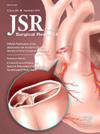Sodium-Glucose Cotransporter-2 Inhibition Normalizes Metabolic Derangements in the Ischemic Myocardium
IF 1.8
3区 医学
Q2 SURGERY
引用次数: 0
Abstract
Introduction
Sodium-glucose cotransporter-2 inhibitors (SGLT2i) have shown efficacy in the context of heart failure but have not been well-studied in ischemic heart disease. We employed a large animal model of chronic coronary artery disease and metabolic syndrome (MS) to investigate the hemodynamic and metabolic consequences of SGLT2i administration.
Methods
Thirty-eight Yorkshire swine were divided into two groups, with half (n = 21) receiving a high fat diet to induce MS, and the other half fed a standard diet (n = 17). All animals underwent thoracotomy for ameroid constrictor placement over the left circumflex coronary artery. Treatment with SGLT2i was then initiated, generating four groups: regular diet placebo (CON, n = 9), regular diet canagliflozin (n = 8), high-fat control (n = 11), and high-fat canagliflozin (n = 10). After 5 wks, all animals underwent terminal myocardial harvest with pressure-volume loop acquisition, perfusion studies, and tissue resection for molecular analysis.
Results
SGLT2i improved multiple measures of myocardial performance, including a nearly 1.5-fold increase in both cardiac output and ejection fraction; these changes were associated with augmented capillary density and a twofold increase perfusion to the ischemic myocardium. These augmentations were blunted; however, in the presence of MS, and associated with modulated myocardial expression of multiple major metabolic enzymes.
Conclusions
SGLT2i significantly improved cardiac function in our large animal model of coronary artery disease, with metabolic modulation of the myocardial tissue serving as a candidate account of these changes. The blunting seen with MS underscores the dependence of clinical translatability on faithful representation of the biochemical environment of human disease.
钠-葡萄糖共转运体-2抑制可使缺血心肌的代谢紊乱恢复正常
简介:钠-葡萄糖共转运体-2抑制剂(SGLT2i)对心力衰竭有疗效,但对缺血性心脏病的研究还不够深入。我们采用慢性冠状动脉疾病和代谢综合征(MS)的大型动物模型来研究服用 SGLT2i 对血液动力学和代谢的影响:38头约克夏猪被分为两组,一半(n = 21)接受高脂肪饮食以诱导MS,另一半(n = 17)接受标准饮食。所有动物都接受了开胸手术,在左侧冠状动脉上放置了气囊收缩器。然后开始使用 SGLT2i 治疗,共分为四组:普通饮食安慰剂组(CON,n = 9)、普通饮食卡格列净组(n = 8)、高脂对照组(n = 11)和高脂卡格列净组(n = 10)。5 周后,所有动物都进行了末端心肌采集,采集了压力-容积循环、灌注研究和用于分子分析的组织切除:结果:SGLT2i 改善了心肌性能的多种指标,包括心输出量和射血分数增加了近 1.5 倍;这些变化与毛细血管密度增加和缺血心肌灌注增加 2 倍有关。然而,在多发性硬化症的情况下,这些增强作用会减弱,并且与多种主要代谢酶的心肌表达调节有关:结论:SGLT2i 能明显改善大型冠状动脉疾病动物模型的心功能,心肌组织的代谢调节是这些变化的候选原因。MS的钝化凸显了临床转化能力对忠实反映人类疾病生化环境的依赖性。
本文章由计算机程序翻译,如有差异,请以英文原文为准。
求助全文
约1分钟内获得全文
求助全文
来源期刊
CiteScore
3.90
自引率
4.50%
发文量
627
审稿时长
138 days
期刊介绍:
The Journal of Surgical Research: Clinical and Laboratory Investigation publishes original articles concerned with clinical and laboratory investigations relevant to surgical practice and teaching. The journal emphasizes reports of clinical investigations or fundamental research bearing directly on surgical management that will be of general interest to a broad range of surgeons and surgical researchers. The articles presented need not have been the products of surgeons or of surgical laboratories.
The Journal of Surgical Research also features review articles and special articles relating to educational, research, or social issues of interest to the academic surgical community.

 求助内容:
求助内容: 应助结果提醒方式:
应助结果提醒方式:


